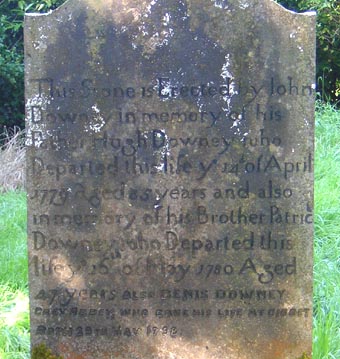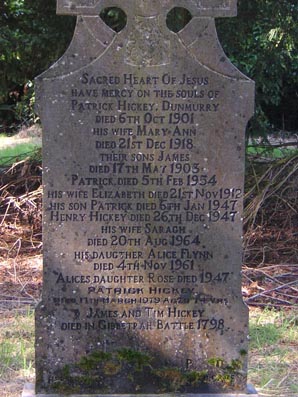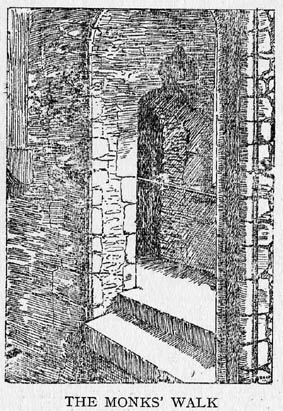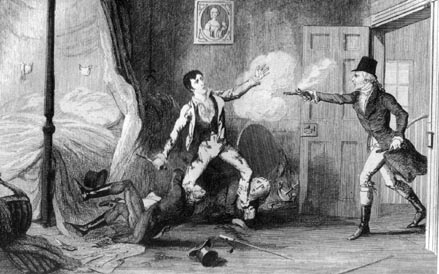« April 2006 |
Main
| June 2006 »
May 30, 2006
AN TOSTAL SOUVENIR PROGRAMME 1953 - CHAPTER 18 Part 2
THE PRESENTATION CONVENT
PATRICK MAHER of Kilrush in Suncroft Parish with his brothers, Thomas and William, made an offer to Fr.Brennan, P.P., Kildare, to found a Convent of Presentation Sisters in Kildare for the education of poor female children. In July, 1829, Father Brennan arranged with the Bishop, Dr. Doyle, that the foundation should be made. The ground on which the convent and Parish Church stand was for disposal and Father Brennan purchased it from Lewis Kelly for £100, aided by Messrs. Maher, Cullen, and Verdon. Father Brennan had the purchase enclosed with a stone wall. A house, garden and school were provided and furnished with every requisite for the Sisters who were to be sent there by the Bishop.
He drew up a lease of the land and houses for three Sisters named by him to the Bishop. These were Sister Angela Mooney, Sister Augustine Maher and Sister Clare Dillon. Sister Angela was sister of Father Mooney, P.P., Rosenallis (1847-76), who built Capard Church in 1863. Sister Augustine was sister of Father James Maher, P. P., Carlow Graig and aunt of Cardinal Cullen. Sister Clare was from Portlaoise and was aunt of Cuffe of Cuffes, Salesmen, Dublin. Father Brennan reserved a rent of £18 for himself and his successors on condition that the convent would give back portion of the land as a site for a future Parish Church. Sister Angela Mooney was appointed first superioress of Kildare by J.K.L. in the Carlow Convent Chapel in the presence of the community and of Sister Augustine Maher, and Sister Clare Dillon who had been professed that day. On Thursday in Easter Week, 1830, at 5 p.m. they arrived in Kildare. A few days later the Sisters opened their school to a small number of pupils. The cottage which housed these pioneer Sisters was on the edge of the road, where the boundary wall stands. A new convent was built in 1839. It was blessed on 22nd, August of that year, and after Mass had been celebrated in it the Sisters took up residence in it. Owing to the increasing number of pupils, Father Nolan, P.P., had the schools adjoining the Convent built in 1869.
In 1854 Sister Catherine Cullen left Kildare to assist in establishing a Presentation Convent in Mountmellick. In 1874, Mothers John Byrne, Paul Fay, Evangelist Kelly and Stanislaus Dunne left Kildare with Mother Xavier Byrne of Presentation Convent, Mountmellick to make a foundation in the far-away mission of Wagga, New South Wales. Their labours were blessed by God as shown by the numerous Presentation Convents now in Australia.
In 1881 the Sodality of the Children of Mary was established in Kildare Convent Schools by Dr. Kavanagh, P.P., The Infants’ School wing was added in 1902. The architect was Mr. Francis Bergin, and the builders, Messrs. D. & J. Carbery. The late Bishop Cullen with the unanimous consent of the ten Presentation convents in his diocese had all the convents amalgamated. He blessed and opened a Mother House and Novitiate at Mount St. Anne’s, Portarlington. The Second Mother-General was Mother Angela Mooney of the Kildare Convent, grand niece of the Foundress. In 1937, to provide for the increased number of pupils—over 500 were now on roll—a new wing was added. At present there are 660 on roll.
Chapter 18 Part 2 of the An Tostal Programme for 1953 is dedicated to the Presentation Convent.
Posted by mariocorrigan at 12:33 AM
May 23, 2006
AN TOSTAL SOUVENIR PROGRAMME 1953 - CHAPTER 18
KILDARE TOWN
A LARGE town had grown up around St. Brigid’s foundation. The Annals record that in 708 and 774 the town was burned. As the buildings were for the most part of wood they were easily burned, but were also easily replaced. The monastery of Kildare being so near the sea-board was one of the first places attacked by the Danes. In 836 a Danish fleet of 30 sail arrived in the Liffey. They plundered every church and Abbey in Magh Lifé, not allowing anyone to escape. They destroyed Kildare by fire and sword and carried away the rich shrines of SS. Brigid and Conleth. Again in 843 the town was plundered by the foreigners, and also in 883, 887, 895, 915, 916, 924, 926, 927, 928, 940, 962, 977, 981, 998. Some of the Irish chiefs also plundered Kildare. The town and church were burned in 1050 and 1067. The town was also burned in 1071, 1089. [, - sic] 1099. [, - sic] 1138, 1143 and 1155. Shortly after the Norman invasion, William Marshall, one of the adventurers who had got possession of this territory, erected a castle for its defence. In 1294 Calbach O’Connor of Offaly took the town and castle by force and destroyed all the rolls of the Earl of Kildare. A Parliament was held here in 1309, and in 1316 the castle and town were granted to John Fitzgerald, who was at that time appointed Earl of Kildare. In the wars during Elizabeth’s reign the town was reduced to a state of ruin. In 1600 the town suffered so severely that the houses were all in ruins, and without a single inhabitant. In 1643 Kildare was made a garrison post under the Earl of Castlehaven, and the town grew in consequence. In 1647 it was taken by Colonel Jones for the Parliamentarians; it fell again into the hands of the Irish but was finally re-taken. by the Lord Lieutenant. By charter of James II the town was governed by a corporation which returned two members to Parliament. The borough was disfranchised at the Union and £15,000 awarded as compensation to the Duke of Leinster. The borough grounds extended considerably beyond the town and included about 3,000 acres of the Curragh and 300 acres south of the town, called the Kings Bog or Commons of Kildare.
According to a return made in 1824 by the Parish Priest, Father Patrick Brennan, there were in that year five schools in the town, four Catholic and one Protestant, as well as a Sunday School. John Cassidy, who had been educated in the neighbourhood, had been teaching in the town since 1810. Attendance, males 25, females 15 Established Church 3, Roman Catholics 37. John Leeson aged 33 had been teaching in various houses since 1816. Attendance, males 21, females 9, Established Church 1, Roman Catholics 29. Denis Murphy had been teaching in this parish 20 years. School 27ft. by l5ft., given free by the convent of this town. Attendance, males 15, females 12, Roman Catholics 27. Mrs. Ravenhill, aged 60, had been teaching in different houses in the parish since 1813. House, mud walled and thatched, about l2ft. square, attendence [attendance – sic], males 25, females, 15, Roman Catholics 40. Daniel McCrone, aged 32, taught in the Protestant School which was open since 1817. Seven Established Church and four Roman Catholics attended. There was a Sunday School held on all Sundays and Holydays in the Parish Chapel. The teachers were Roman Catholics, excellent moral characters, forming a Society in themselves, and teaching under the superintendence [superintendence – sic] of the P.P. and his curate, who at that time was Father Michael Nowlan. Attendance, males 289, females 255, Roman Catholics 544. Attendance last winter (1823-24) 500. Summer 1823, 686. One half can read. The books were the Four Archbishops’ Catechism, Abridgment of Christian Doctrine. Father Brennan points out that a great majority of the children are deprived of the ordinary means of education, and this was not from any indifference in the children or parents towards education, but from lack of means. Father Brennan stated there were upwards of twelve hundred children under his spiritual care: he was speaking of Rathangan as well as Kildare. The National School system was introduced in 1833. In 1837, according to Lewis, p.86, there were in the town three public schools in which about 800 children were taught, and a private school in which there were about 70 children. The parish in that year had a population of 2,541, of whom 1,753 lived in the town, in which there were 346 houses.
[William Marshall is credited with erecting the castle at Kildare but it is likely that a castle was first erected in Kildare Town by Strongbow as a means of safeguarding his interests in the town; The reference to 1294 is confused - there was no Earl of Kildare until 1316 and indeed Fitzgerald apparently engineered a raid on Kildare around the same time that O'Connor did; Lewis – Samuel Lewis’s Topographical Dictionary of Ireland, published 1837 – the entry for Kildare can be found in the Archive section of this website; all references in Lewis to County Kildare can be found at www.kildare.ie/heritage - Mario Corrigan]
Chapter 18 of the An Tostal Programme of 1953 examines the early history of Kildare Town and the development of education in the town in the early 19th century.
Posted by mariocorrigan at 10:13 PM
May 14, 2006
AN TOSTAL SOUVENIR PROGRAMME 1953 - CHAPTER 17
GIBBET RATH
IN the 1798 insurrection the United Irishmen of the two baronies of Uibh Failghe in Co. Kildare had risen. General Dundas had withdrawn his regular army and militia from the Kildare men’s area into Kilcullen. Kildare was occupied by the insurgents under Captain Garry of Kildare on the evening of the 24th May. On the 25th May, Captain Padraig O’Beirne of Nurney had led the men of Kildoon, Kildangan, Nurney and Riverstown in an attack on the Monasterevan Yeomen Garrison. Rathangan was taken on 26th May by a force under John Doorly of Lullymore, but on 28th May they were driven out by a combined force of British horse, foot and artillery. The general position in Kildare was one of stalemate. The King’s troops occupied large camps or fortified towns while the United Irishmen held the country. But Dublin had failed to rise and the men of Carlow had suffered a disastrous defeat on 25th May. General Dundas had offered favourable terms, including the raising of free quarters, and an amnesty for all insurgents who would lay down arms. These terms had been accepted by the Kilcullen men. General Dundas, accompanied only by two dragoons, had gone to Knockaulen and accepted the arms from the insurgents. On the morning of 29th May, General Sir James Duff arrived from Limerick and was marching on Kildare with reinforcements, 250 militia infantry, two six pounder guns and 70 of Lord Roden’s Fencible Cavalry. On his way he had collected about 200 of the South Cork Militia Regiment with their two battalion guns. [, - sic] about 50 of the Fourth Dragoon Guards, and some of the Monasterevan Yeomanry of both Bagot’s and Hoysted’s corps. One Cooper of Ballymanny acted as intermediary and advised the people of Kildare to proceed to the Rath of the Curragh, saying that he himself would undertake to persuade General Duff to take their surrender there. The Kildare people did so. Duff commanded the rebels, as he called them, to throw their arms in a heap. He then ordered the troops to charge and spare no rebel. The cutting down of the unarmed men was too easily accomplished. The number of Kildare men who were massacred was 325. In one street alone of Kildare town, 85 widows were counted the following morning—Fr. Hurley, S.J. Lecture in Kildare, Leinster Leader 17/6/1950.
In a plot about 25ft by 40ft. enclosed by a 3ft. wall in Kildangan graveyard there is a slab 1ft. 9in. x 3ft. at each end. On one is inscribed “the burial ground of Stephen Rice, Cherrymills, 1795,” and on the other “the burial place of John Hoysted, Walterstown, 1795.” There is also a flat broken stone inscribed “This monument is in memory of John Hoisted, Esq., Walterstown, who died 28 March 1848.” The plot is called “Hoysted’s barn.” A few yards away adjoining Father Hanigan’s grave in the same graveyard is a stone inscribed:“here lies the body of Thomas Murphy who departed this life May 29, 1798, aged 49 years. Also the body of Patrick Murphy who departed May 29, 1798, aged 45 years. Erected by their wives Bridget and Madge.” Near the Boland plot is an old tombstone inscribed: Erected by James Gilmor in memory of Michael Gilmor who departed this life June 7, 1798, aged 30 years. R.I.P.”
[Two baronies of Uibh Failghe are the two Baronies East and West Offaly or Ophaely; free-quarters – soldiers were billeted on the local populace at the expense of the local populace; Knockaulen read Knockaulin or Dun Alinne ]
The Grey Abbey Conservation Project have recently cleaned up Dunmurry Cemetery. Our thanks to Frank, Paddy and Christy for their brilliant work. There are two graves in Dunmurry which had information added about family members who lost their lives at the Gibbet Rath - Denis Downey of Grey Abbey whose story was retold by Fr. Swayne in his book Kildare in '98 and also Tim and James Hickey. I took these photos on 18 September 2005.


Chapter 17 of the An Tostal Programme 1953 is dedicated to the Massacre at the Gibbet Rath in May 1798. I have included two photographs of related gravestones in Dunmurry Graveyard. This graveyard was recently cleaned up by the Grey Abbey Conservation project.
Posted by mariocorrigan at 03:27 PM
May 08, 2006
AN TOSTAL SOUVENIR PROGRAMME 1953 - CHAPTER 16
LORD EDWARD FITZGERALD
LORD EDWARD was the son of the Duke of Leinster and was born in 1763. He spent his early years in Kildare and when he was about ten years old the family moved to France. The life of a soldier appealed to him and he joined the English army. He fought against the American insurgents, and he distinguished himself by military skill and a chivalry that made him the hero of the army.
On his return to Ireland he became a member of the corrupt Parliament of College Green. The dishonesty he met in that assembly forced him to champion the cause of the downtrodden people. He refused promotion rather than betray his principles.
In 1792 he visited France and adopting revolutionary ideas he renounced his titles. Because of these tendencies, he was dismissed from the English army. While in France he met and married the beautiful Pamela, daughter of Philip Egalite, Duke of Orleans. He returned to Ireland with his young bride and lived in Leinster Lodge which was given, to him as a wedding present.
Here he was singularly happy and very popular with the ordinary people. He encouraged native games and pastimes and threw himself into the independence movement. With his handsome bride he attended the pastimes and gatherings of the people. Crowds lined the streets as he took Pamela to Mass in the little Penal Chapel on Chapel Hill.
But the Government, through its spies, had been watching Lord Edward and the United Irishmen. Goading the people to rebellion they suddenly arrested the leaders. Lord Edward had been in hiding since March 1798 and on the 19th May he was surprised in the house of Thomas Murphy in Thomas Street, Dublin. After a fierce encounter in which two of his assailants were wounded Lord Edward himself was wounded. and overpowered. He was carried to Dublin Castle and thence to Newgate Jail. Here he lingered for some time and on June 3rd, 1798 Lord Edward died. His remains were placed in a vault under the East end of St. Werburgh’s Church.
[Because the article specifically relates to Lord Edward I have included Cruickshank's image of the Arrest of Lord Edward FitzGerald from Maxwell's History of the Rebellion]
Chapter 16 of the An Tostal programme of 1953 is dedicated to the United Irishman, Lord Edward FitzGerald, who lived for a short time in Kildare Town with his beautiful French wife, Lady Pamela. In 2003 on the 205th anniversary of his death a bust of Lord Edward was unveiled on the Market Square.
Posted by mariocorrigan at 10:50 PM
May 02, 2006
AN TOSTAL SOUVENIR PROGRAMME 1953 - CHAPTER 15
KILDARE AND THE CURRAGH
IN 1790
FATHER NOWLAN, P.P.
TOPHAM Bowden, an Englishman who travelled Ireland in 1790 thus writes: “The Curragh of Kildare is unquestionably the most beautiful plain in Europe. The day I crossed it happened to be remarkably fine, which added much to the picturesque appearance of this charming scene. It is about twenty miles in circumference and I do suppose every square perch of it contained a sheep. The verdure and the inequality of the surface, its slopes and eminences mottled with sheep, presented a delightful view.
“While I remained on this heavenly lawn, I had reason to bless my good genius that I had a sound carriage and a safe driver; for though the road was very fine, no less than three carriages broke down in my view; two of these carriages happened to be empty; in the third was a Mr. Nowlan, Parish Priest of Kildare, who had a most fortunate escape. I was happy in accommodating him with a seat in my carriage to Kildare. On the way he informed me he had been visiting an old parishioner of his, then confined for debt in Naas, and that he had given his horse to a gentleman to ride back to Kildare, as he had an opportunity of riding in a post carriage. From such post carriages, good Lord deliver me.
“As Mr. Nowlan received not the least injury, I rejoiced in the accident that introduced him to my acquaintance. He is really a sensible and well-informed man. He pressed me to dine with him; he said he was to have a few friends with him that day; and as I had no acquaintance in the town I readily consented. Among his guests were a Mr. Bergin and his family of that town, a Mr. Kelly and a Mr. Higgins. Mr. Bergin has a good knowledge of the world and his wife is a very genteel woman. In the course of conversation I learned that his Grace of Leinster, to his honour be it recorded, had given a few acres of land adjoining the chapel to the Parish Priest and his successors for ever at a moderate rent; and Mr. Bergin proposed to the company to build on this ground a house for their priest. This, I remarked, would be convincing his Grace that they entertained a proper sense of the obligation he conferred on them. In this opinion they all coincided, and they resolved on erecting the house immediately.
“The town of Kildare stands on a great eminence, about half a mile from the Curragh, and commands a very extensive prospect to the East, South and West. Though inconsiderable at present, it contains many relicsof [relics of - sic]ancient magnificence, a circular road with twelve roads leading to it, the ruins of a castle, three monasteries of friars of different orders, a convent of the nuns of St. Clair, a parish church and a very large cathedral, the greatest part of which was destroyed by Cromwell to gratify the fanaticism of his soldiery.
“On the north side of the cathedral stands a round tower’ similar to that at Clondalkin but much higher . . . The door is fourteen feet from the foundation and the summit one hundred and thirty. Near this is a small oratory of St. Brigid . . . The ruins of the citadel or castle of the Earls of Kildare prove it to have been of uncommon extent.
“Few people …… come …… since it was deserted by the Leinster family, except during the Curragh meetings, and then it swarms with gentlemen, sharpers and beggars. To the north of the town is a range of hills of moderate height and easy ascent, called the Red Hills, from the redness of the earth I suppose. There is a copper mine here said to be very rich, which is working these three years past, not with that spirit however which can only render undertakings of the kind of public importance.”
Chapter 15 of the An Tostal Programme of 1953 features a description of a chance meeting bewteen an English traveller, Topham Bowden, and Fr. Nolan, P.P. of Kildare, on the Curragh in 1790.
Posted by mariocorrigan at 11:43 PM



